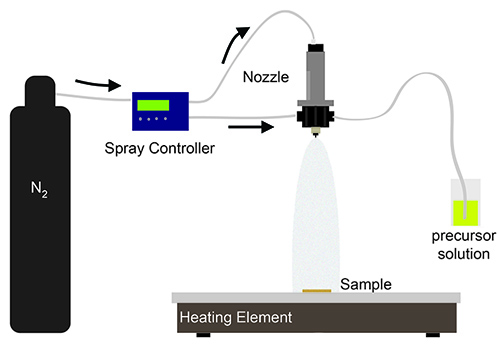Institute Solar Fuels
Wet chemical methods
Spin coating
Solution-state precursors such as metal alkoxides, metal salts and metal-chelate complexes are used to process metal oxides electrodes by a variety of deposition techniques such as drop-casting, spin-coating, chemical bath deposition and spray pyrolysis. Depending on the technique, the choice of precursors, solvents and additives can have a significant impact on the morphology, composition, surface area, crystal structure of the oxide films which in turn affect the photoelectrochemical properties of the electrodes. In solar fuel research scientists are exploring ternary, quaternary and even more complex oxide and the challenge for wet chemistry is to maintain homogeneity at the molecular or atomic level during the deposition process.
The spin‐coating procedure can be repeated multiple times to obtain the desired thickness, as illustrated schematically below in the case of BiVO4 photoanodes. In addition the composition of each layer can be adjusted to create a composition gradient to achieve a better separation of the photogenerated charges and their transport toward the electrode surface.
Spray pyrolysis
In spray pyrolysis, a precursor solution containing the metal element(s) is fed to a spray nozzle. Inert carrier gas, such as N2 and Ar, is used. At the Institute for Solar Fuels, we use an air atomizing spray nozzle, which breaks down the liquid precursor into the smallest possible drop size. The droplets are directed onto a substrate, which is placed on a hot plate. By controlling the substrate temperature, spray distance, spray rate and post annealing temperature, crystalline thin film metal oxides can be deposited. Several metal oxides with deposited area as large as 100 cm2 have been deposited in our institute: bismuth vanadate (BiVO4), copper bismuth oxide (CuBi2O4), tin oxide (SnO2), iron tungstate (Fe2WO6) and iron vanadate (FeVO4). The schematic of our setup is shown in the figure below.


